PRESTO PLANS
Sent straight to your inbox
CLICK HERE TO ACCESS
Sign up to receive 10 ready-to-use ELA resources your students will love!
10 FREE ELA RESOURCES
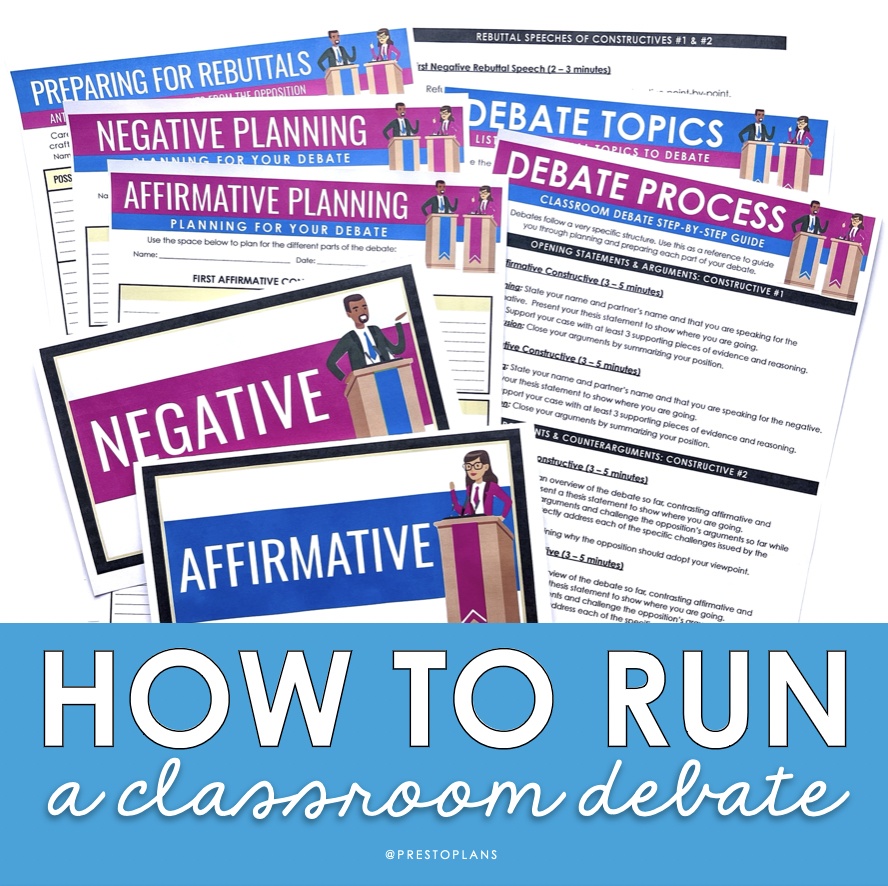
How to Run a Classroom Debate
In my opinion, learning how to run a classroom debate is one of the most versatile skills an ELA teacher can have! I think the debate is one of those rare “perfect” classroom activities for middle and high school ELA. When run effectively, debates can offer a masterclass in a number of essential language arts skills, including researching, reading, writing, speaking, and actively listening. I also firmly believe conducting a debate helps students build important life skills—with many applications beyond the walls of the classroom.
You might be running the school debate club, planning a debate unit with your middle or high school ELA class, or just wondering how to run a classroom debate as a one-off activity related to a novel or current event. However you choose to incorporate debate into your learning space, here are my best tips and tricks for making the most of the experience in your learning space.
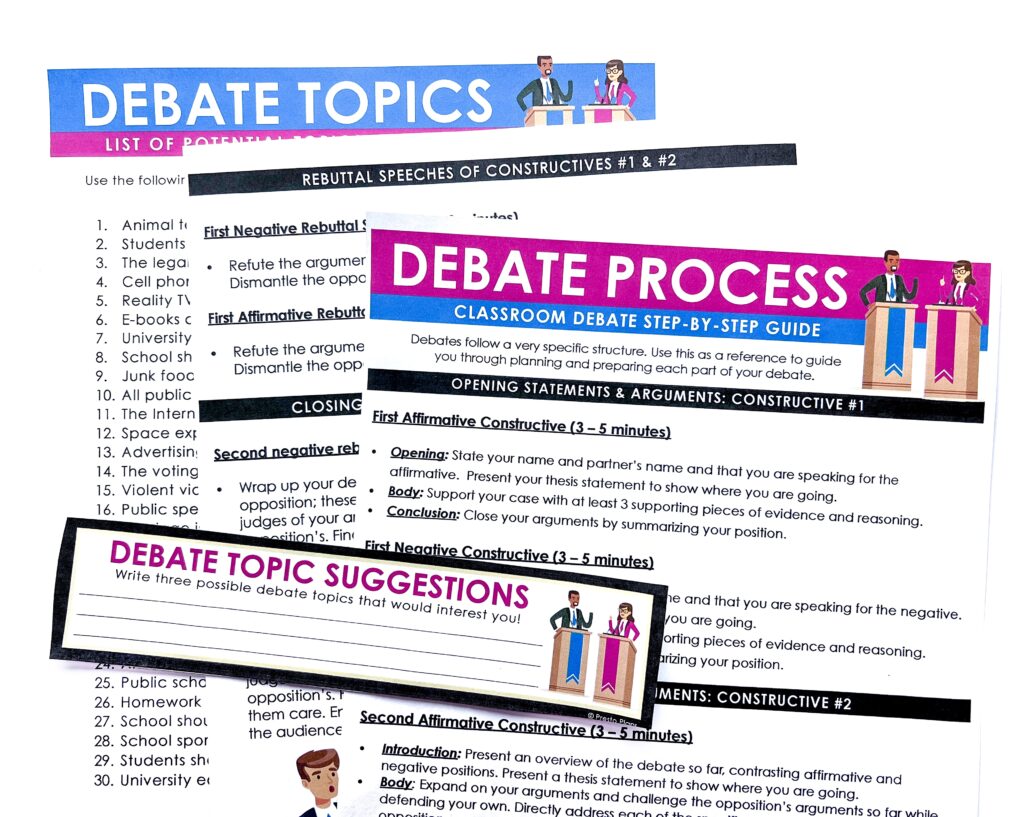
What is a Debate?
First, I like to start the lesson by introducing the idea of debate. Depending on your group, some students may already be familiar with the concept of a structured argument, and for others, it might be completely new! To level the playing field, I explain that a debate is a formal discussion or argument between two or more individuals (or teams) presenting opposing viewpoints on a specific, pre-defined topic.
The goal of a debate is to persuade the audience to support one side of the issue over the other. Although there are several debate formats, they all generally adhere to a similar structure that allows both sides to present arguments and rebuttals.
Why is Debate Important?
Once students have a basic handle on the idea of debate, the next step is to explain why debate is important. There is a common misconception that debate is a skill only used by politicians – this isn’t true! To illustrate the importance of debate, I like to present some hypothetical scenarios to middle or high school students:
- Imagine you are an adult and you have a disagreement with a co-worker about the best way to move forward on a project. How will you handle this situation?
- Your group of friends is split between two movies that they want to see. How can you resolve the conflict?
- Pretend that your boss has asked you to take on some new responsibilities at work, but you feel like these expectations are unfair. What would be an effective way to have a difficult conversation with someone who may not share your perspective?
Usually, it doesn’t take long for students to identify that skills involving critical thinking, diplomacy, professionalism, and problem-solving are needed to tackle these challenges. From here, I like to connect these scenarios back to the basic principles of debate, and how this activity can help build these essential life skills.
Choose Debate Topics
Now that students are (hopefully) excited about the upcoming debate, it’s time to choose a topic of discussion! Depending on how you choose to run your classroom debate, you may wish to have pairs of students debate each other (in which case, you’ll need several topics!), or you may instead wish to have students work in larger groups to prepare arguments for or against a single topic.
Either way, your students will need something to debate about! Debate topics can span a wide range of subjects, from current events and politics to social issues, science, technology, and more. An important thing to note about debate topics is that they should always be written in the form of a statement (not a question). I also emphasize that they should be specific – and something that people might have multiple perspectives on. This makes debates more interesting and relevant.
If you are connecting your classroom debate to a specific unit of study that is already taking place in your ELA curriculum (such as a novel study), you might already have a topic in mind, or you might have your students pitch topics to you! But if you are wondering how to choose topics to run your classroom debate, prepared task cards can really help focus your students and keep everyone on track.
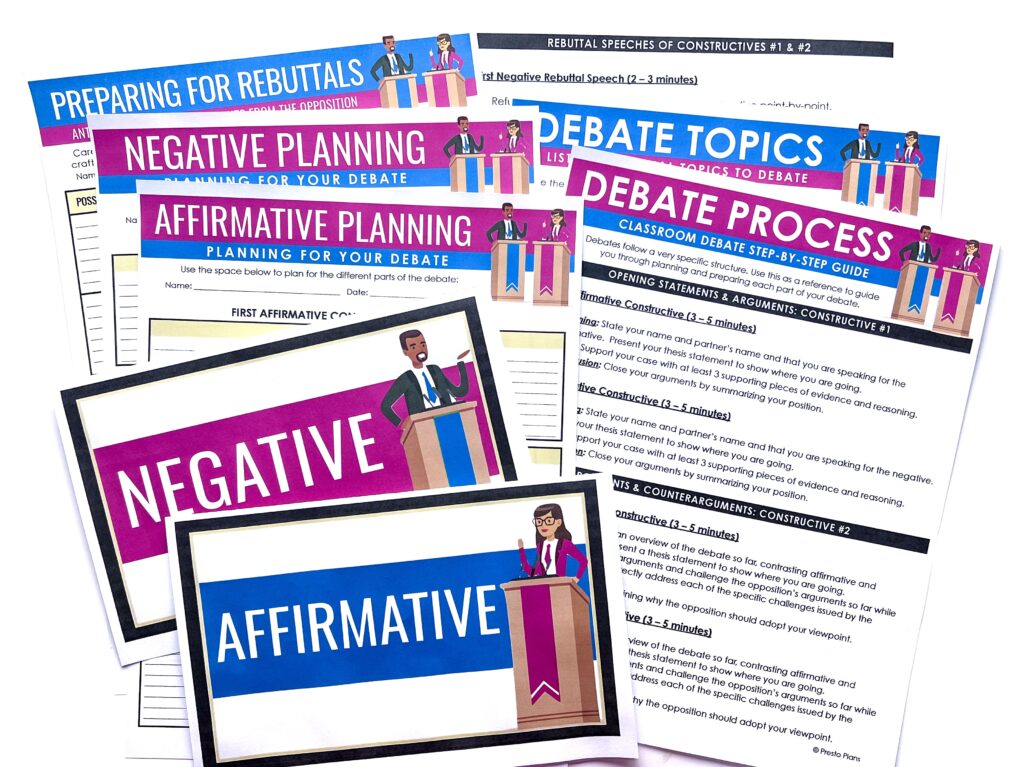
Affirmative Vs. Negative
Once you’ve chosen your topics, it’s time to divide up your class. When considering how to run a classroom debate, remember that there is real value in having students debate on the “other side” of an issue they feel strongly about, and consider an unfamiliar perspective! You may want to have students decide which side they want to be on, or you may prefer to decide for them. Generally, in debate, “affirmative” means that a debater or team argues in favor of the topic. Likewise, “negative” means that the debaters argue against the resolution.
Depending on how many debates you plan to do, and how many topics are up for discussion, students may be working in partners or larger groups as they brainstorm their ideas. At this point, you might also wish to assign other debate-related jobs. Perhaps some students can take on the role of researcher, providing information that can be used during the debate. Students who are not directly involved in debating can also take on the roles of timekeeper, moderator, or debate judge.
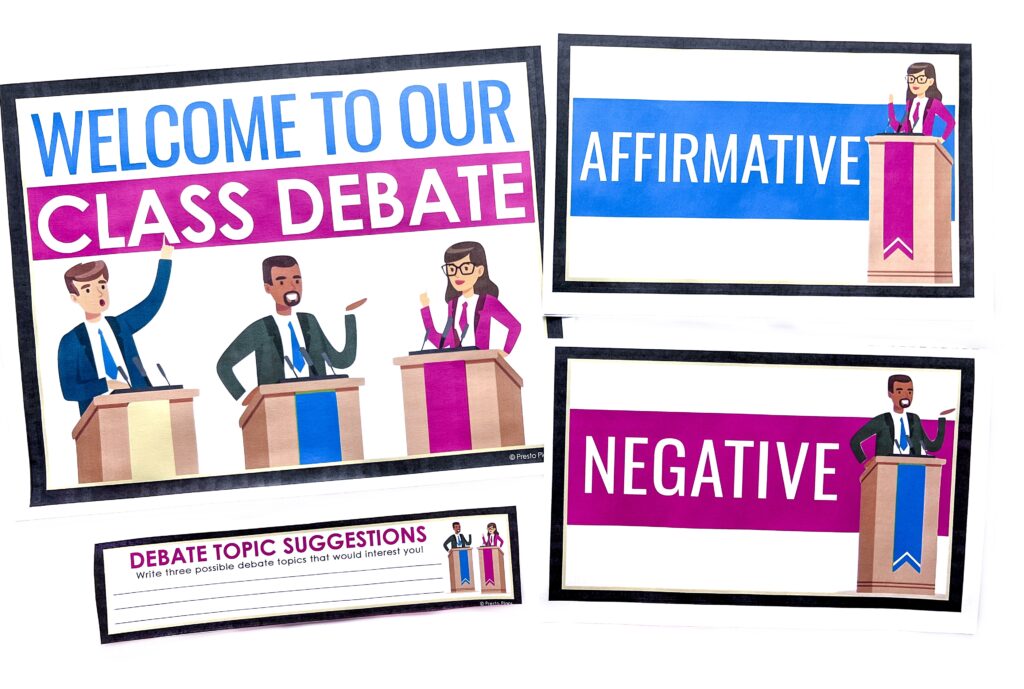
Preparing Arguments
As debaters prepare their arguments, this is a good time to remind them of the importance of using credible sources. You may have already done some work around evaluating the validity of online sources. In this case, the Website Credibility Checklist will help them remember what to look for when carrying out web-based research.
Debates are also a great opportunity to learn more about finding credible sources for the first time! If this is the case, you may wish to quickly share what to look for when conducting research on the internet. Activities for evaluating credible sources and boosting media literacy skills can really help reinforce this lesson before your students get back to their debate preparations.
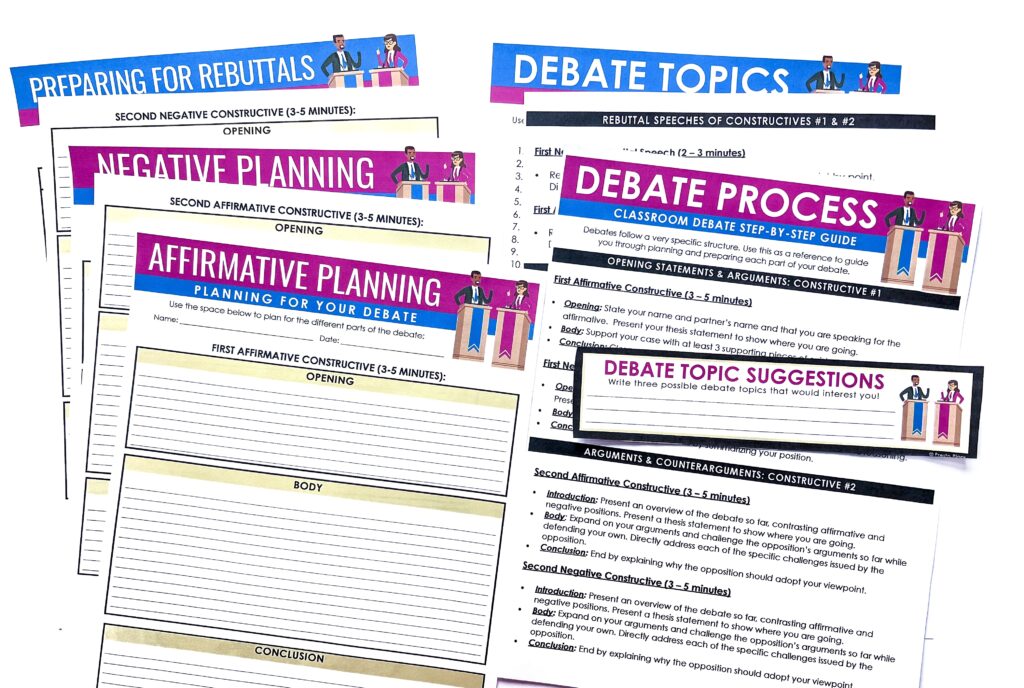
Debate Structure & Rules
From here, you’ll also want to make sure that your students have a good understanding of the structure and rules of a debate. If you’re wondering how to run a classroom debate the “right” way, don’t panic – there are many different ways to run a debate! If your debaters are competitive, you may wish to check out the specific rules that apply to inter-school tournaments in your local area. But for the purposes of ELA class, I like to run classroom debates in a two-on-two format, with one pair of debaters representing the affirmative side, and the other representing the negative side.
In this format, each debater has the opportunity to speak once (beginning with the first affirmative speaker and alternating sides). Once all four debaters have had the chance to speak, they take a brief break to collect their thoughts, and then repeat the same process one more time with rebuttal speeches. Depending on the time available to you, you might also want to introduce opportunities where debaters can directly ask each other questions (managed by a moderator)!
Once students are familiar with the overall process of the debate, I walk them through the process of organizing effective speeches. These include making a strong opening statement, outlining well-supported arguments, and leaving time to address counterarguments made by the other team. I find it really useful to address the issue of timing here – students should have a good idea of how long their speeches are.
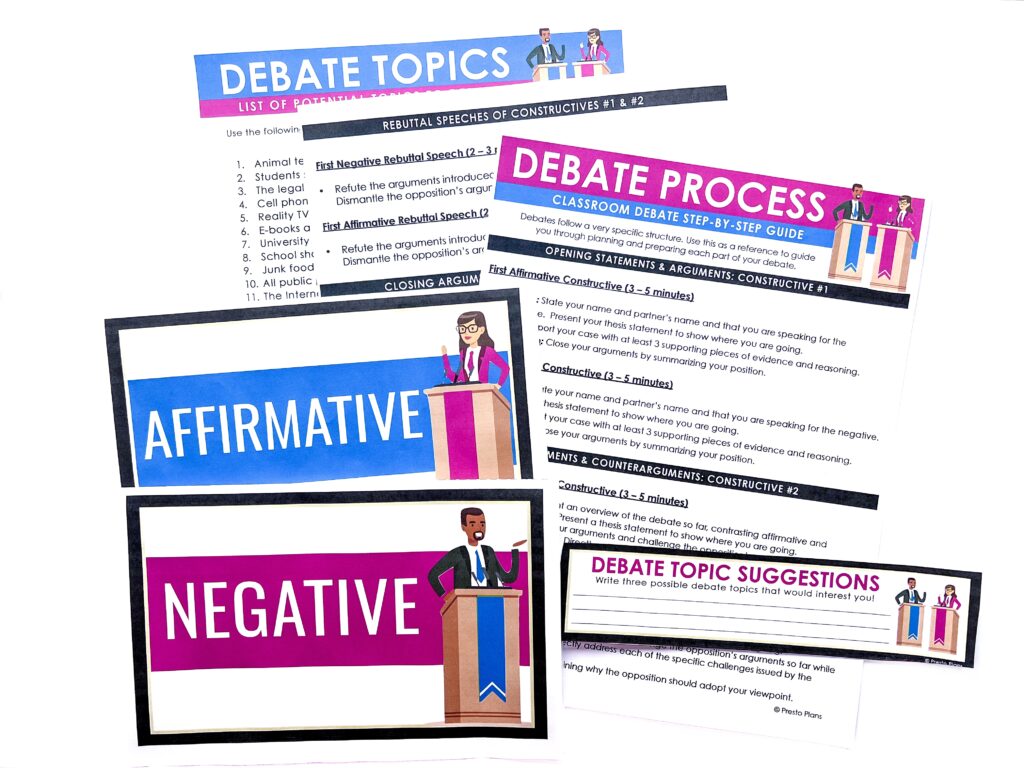
Debate Etiquette
Before students get going with their first debate, I like to make sure they also have a solid understanding of debate etiquette. Given their formal nature, debates often come with a variety of rules, practices, and guidelines that should be followed. The most important rule of all, however, is to always be respectful during the debate.
To wrap up, explain that since debates thrive on the exchange of opposing viewpoints, it is easy to imagine how students might have an emotional response to an argument or claim. This is normal! To ensure the effectiveness of debates, however, students must not disrespect the opposing team in any way. Doing so tarnishes the integrity of debates.
Feedback & Reflection
At the end of the debate, it’s important to provide all students – not just the ones who were directly involved – with some feedback and reflection. This helps everyone learn from the experience, and plan for the next time! If you appointed some students to judge the debate, you might wish to invite them to comment on what each debater did well or analyze the effectiveness of each side’s arguments. One way to do this is to use the “Three Stars and a Wish” format (three compliments for every area of improvement). Alternatively, debaters and judges could also complete a brief written self-evaluation, identifying areas of strength and growth.
There you go! I hope you have a blast conducting a debate unit in your ELA classroom! Grab the ready-to-use resource below with everything you need to run a classroom debate.
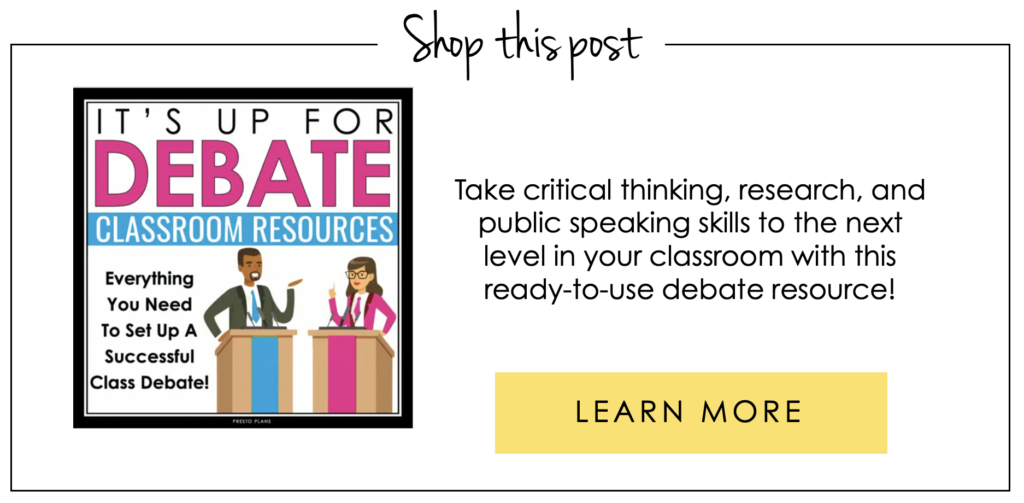
Looking to support students with research skills? Check out my post on Helping Students Find Credible Sources in Online Research!
Search the blog for what you are teaching
GIVEAWAYS
sent straight to your inbox!
share this post